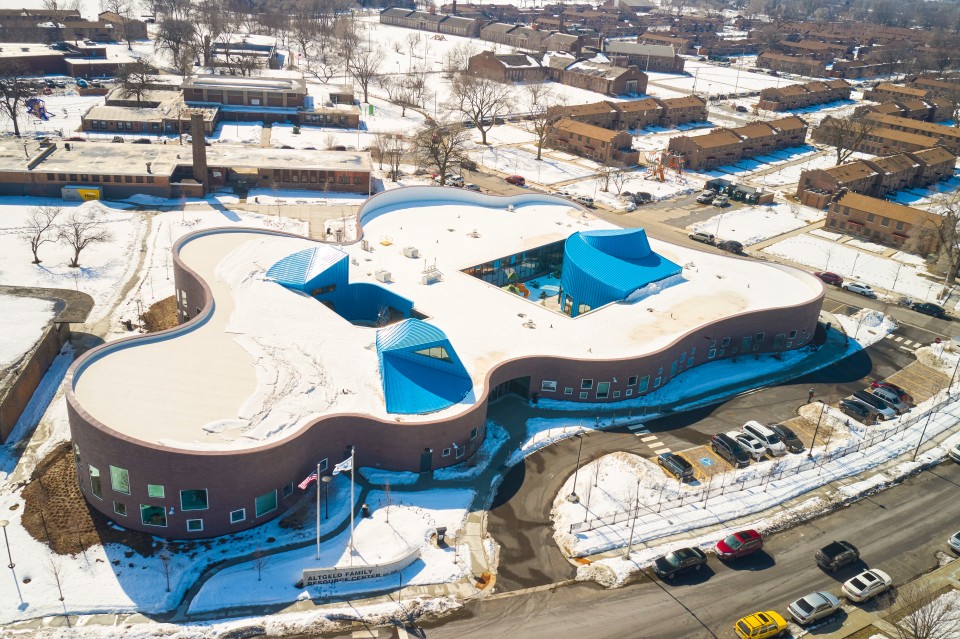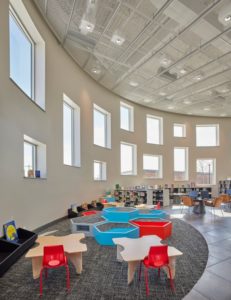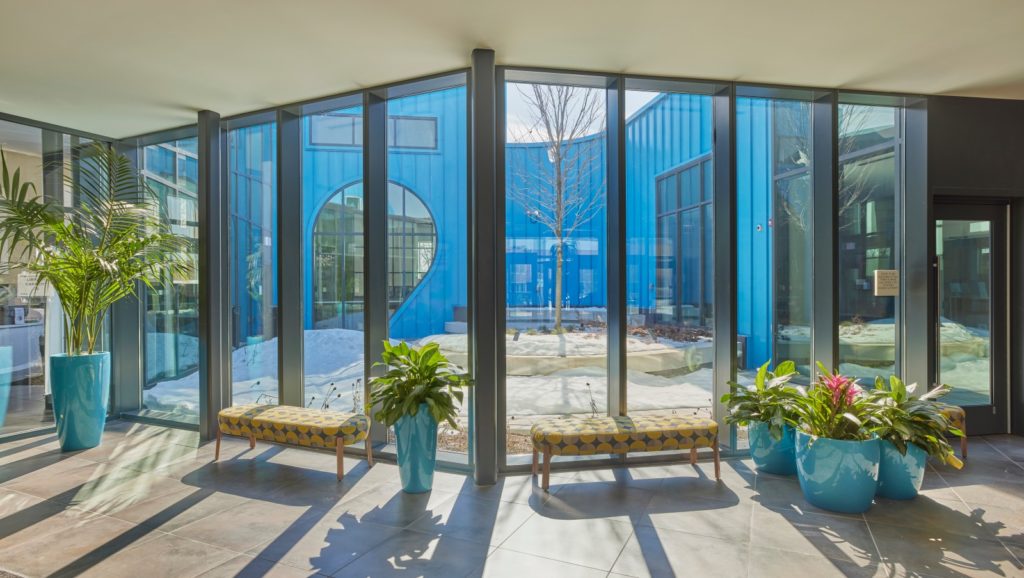This blog was originally posted by WBEZ Chicago on March 27, 2021.
Written by Dennis Rodkin.

Lots of Chicago-area buildings make you stop and ask: “What’s that building?” WBEZ’s Reset is collecting the stories behind them! You can also find them on this map.
Since Altgeld Gardens opened in the mid-1940s, nearly all of the buildings at the Chicago Housing Authority development on the Far South Side have consisted almost entirely of right angles.
The sharp angles are seen in the dozens of two-story townhouses in the 190-acre development, as well as at the nearby George Washington Carver Park fieldhouse and Ira Aldridge Elementary School.
But last summer, a new style came to Altgeld Gardens: A curvalicious, amoeba-shaped building with bright blue triangular peaks poking out of its top. The Altgeld Family Resource Center at 930 E. 131st St. clearly signals something different.

Dan Rappel — the architect at the Chicago architecture firm Koo, which led the design of the 40,000-square-foot building — said the resource center’s shape, enhanced by its scattered arrangement of windows, is “exuberant.” The three curved sections have three uses: a child care center, community meeting rooms and a branch of the Chicago Public Library.
The interior of the Altgeld Family Center is as exuberant as the exterior. The light streams into the library through the many windows and two enticing interior courtyards — one with a children’s playground. The interior also features handsome modern rooms like the one Rappel called “a cathedral for play,” which sits in the daycare wing and features a large area for kids to play. The area has an angled take on a domed ceiling, with a polygonal window near the top to let daylight spill down.

But it’s not just the aesthetics that makes the resource center a departure from the status quo at Altgeld Gardens. The building was designed with a keen focus on sustainability.
The building is called “net-zero ready,” which means that if the CHA goes forward with a farm of solar panels (not on the building), the family center will use the same amount of energy as it generates, or less. There’s also a stormwater retention program that doesn’t dump into the sewers, building materials and finishes that are low in volatile organic compounds, and other sustainability features.

Building sustainably is often lauded as a good move, but here at Altgeld it marks a win in a longstanding fight for environmental justice. When it was built in the 1940s, Altgeld Gardens was constructed with Black veterans returning from WWII in mind, many of whom worked in the steel plants and other industrial sites on the Far South Side.
While it was intended to be a picturesque little town within Chicago’s city limits, it was really more of an island, mostly surrounded by a landfill, polluting heavy industries and the Little Calumet River, full of toxins from those industries.
Beginning in 1969, Altgeld resident Hazel Johnson worked to document the pattern of chronic health problems among her fellow residents in the place she called “The Toxic Donut,” with Altgeld being the hole at the center.
Johnson is now thought of as a pioneer of the environmental justice movement and is sometimes called the Mother of Environmental Justice. For decades she led a battle to draw attention to the problems at Altgeld’s site, including asbestos used in the buildings’ construction and polluted drinking water. One of her collaborators was Barack Obama, early in his community organizing days in Chicago.
Decades later, the new family resource center opened as probably the most sustainable new building the CHA has ever put up, said Kevin Hall, the housing authority’s director of planning, design and engineering.

The center fills a spot that had been empty since Altgeld Gardens opened in 1945. Despite the fact that it’s the focal point of the entry road and surrounded by hundreds of homes, the spot never got the “town center” that was planned. The center’s design as a “360-degree building” is meant to make it approachable from all sides, Rappel said.
Nearby 130th Street, which runs along the north side of Altgeld Gardens, is now named in honor of Hazel Johnson. And her legacy is equally present at the brand-new, vibrant and environmentally positive building on 131st Street.
Dennis Rodkin is a real estate reporter for Crain’s Chicago Business and Reset’s “What’s That Building?” contributor.
